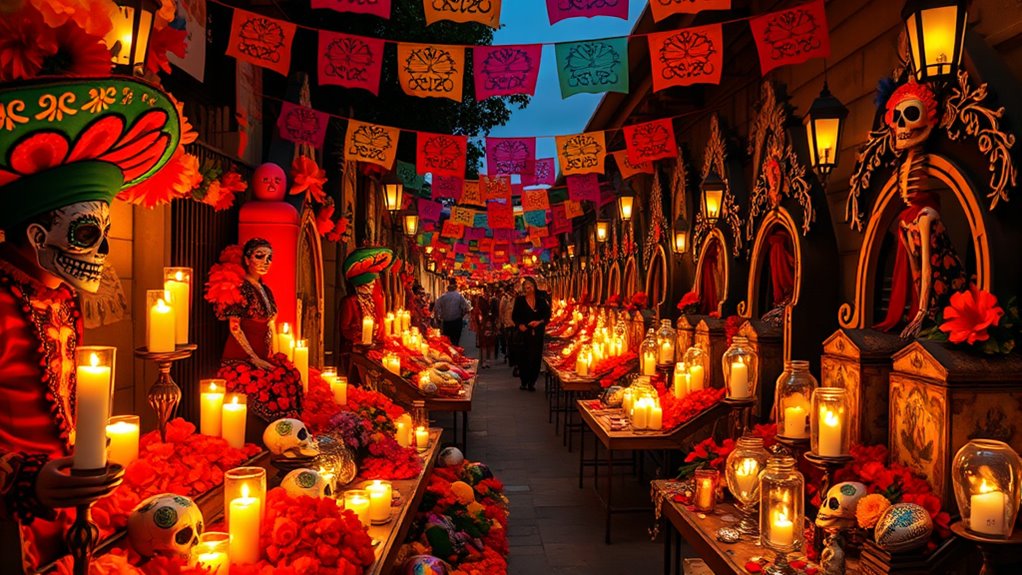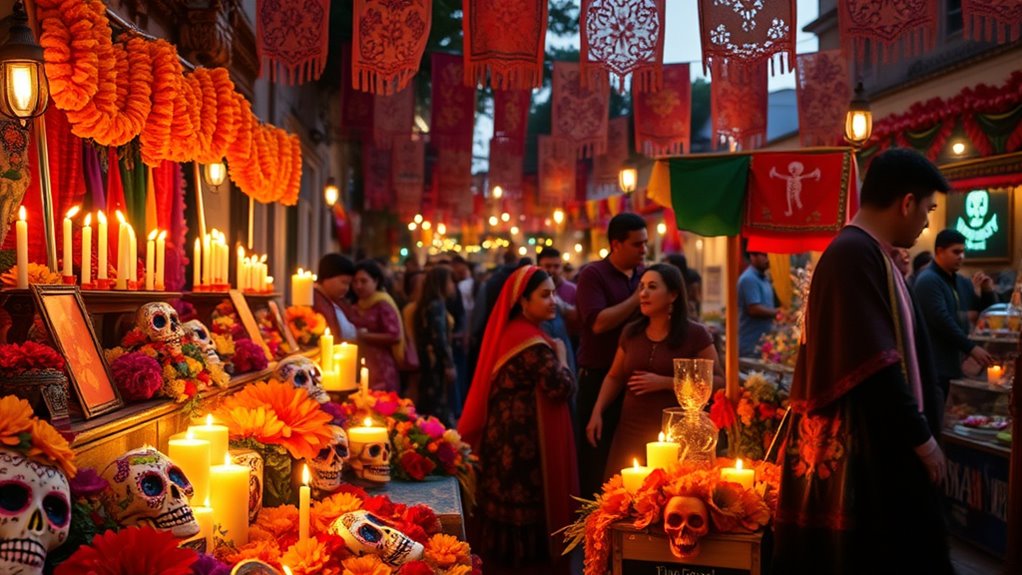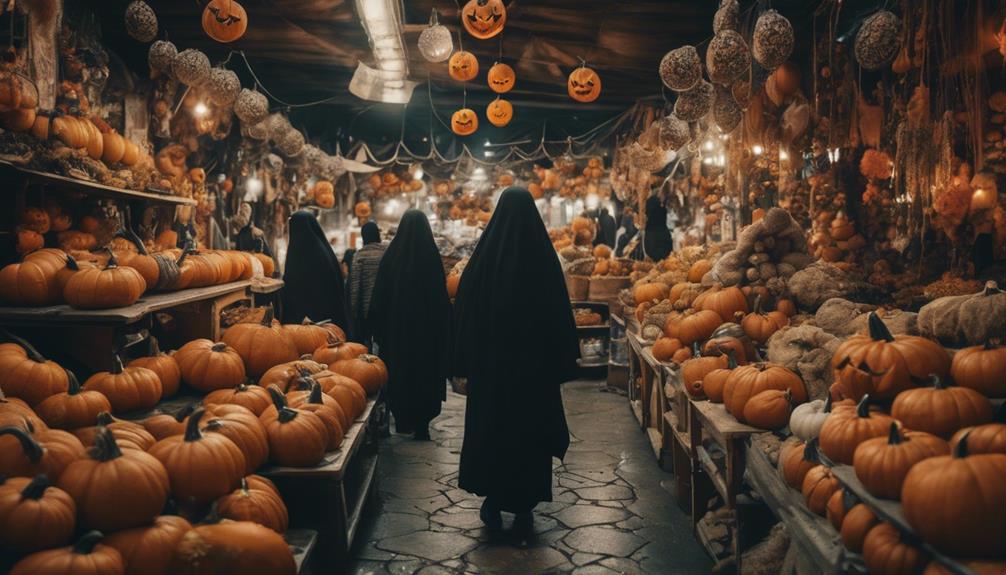During Mexico’s Day of the Dead, you’ll see colorful altars decorated with candles, marigolds, papel picado, and photos of loved ones. Traditional foods like pan de muerto and candies shaped like skulls are offered to nourish spirits. Streets and homes come alive with vibrant decorations, sugar skulls, and cultural symbols that celebrate life and death. The community gathers to remember and honor ancestors, creating a meaningful connection that blends culture, memory, and love. Keep exploring to learn more about these rich traditions.
Key Takeaways
- Altars decorated with candles, marigolds, papel picado, photos, and personal mementos honor deceased loved ones.
- Traditional foods like pan de muerto, tamales, and candies are offered to nourish spirits.
- Vibrant symbols such as sugar skulls and colorful decorations celebrate life and death as interconnected.
- The celebration is a communal activity that strengthens family bonds and cultural identity.
- Altars and offerings serve as heartfelt expressions of love, remembrance, and respect for the departed.

Every year, Mexicans celebrate the Day of the Dead with vibrant traditions that honor their deceased loved ones. You’ll notice that a central part of these festivities involves creating altars and offerings, which serve as welcoming spaces for spirits to return. These altars are beautifully decorated with candles, marigold flowers, papel picado, and personal mementos. You might see photographs of the departed, along with their favorite items, to guide and invite their spirits back home. Each element on the altar holds significance; the candles light the way for spirits, while marigolds, with their bright orange hue, are believed to attract and guide souls with their scent and color.
A key feature of these altars is the assortment of traditional foods carefully prepared and arranged. You’ll find dishes like pan de muerto, a sweet bread shaped to resemble bones or skulls, which is a staple for this celebration. Other offerings include tamales, mole, and various candies crafted in the shapes of skulls and skeletons. The foods aren’t just for the living—they’re meant to nourish the spirits during their visit. When you participate in setting up these offerings, you’re engaging in a deeply rooted act of remembrance, creating a bridge between the living and the dead through tangible symbols of love and memory.
As you walk through the streets of Mexico during these days, you’ll see altars in homes, cemeteries, and public spaces, each filled with vibrant colors and meaningful artifacts. It’s common to see sugar skulls (calaveras) and decorative items that celebrate the cycle of life and death. These elements serve to remind everyone that death isn’t an end but a continuation of existence, woven into the fabric of daily life. The process of preparing altars and traditional foods is a communal activity that brings families and communities together, reinforcing bonds through shared memories and collective reverence. Incorporating authentic cultural symbols such as traditional crafts and regional foods further enriches the celebration and honors local heritage.
In essence, the altars and offerings you observe are more than just decorations—they’re heartfelt expressions of love, respect, and remembrance. The traditional foods you see are not only delicious but also symbolic, representing the joy of life and the enduring connection with those who have passed away. When you immerse yourself in these traditions, you participate in a vibrant cultural practice that celebrates life, honors the deceased, and keeps their memories alive year after year.
Frequently Asked Questions
How Do Different Regions in Mexico Celebrate the Day of the Dead?
You’ll notice regional differences in how communities celebrate, with customs varying from place to place. Some regions create elaborate altars with specific local foods and flowers, while others focus on vibrant parades and music. In coastal areas, celebrations might include beach offerings, and inland communities may emphasize religious ceremonies. These community customs reflect local traditions, making each celebration unique and rich in cultural significance across Mexico.
What Are the Traditional Foods Prepared During the Festivities?
Did you know that during the Day of the Dead, families prepare over 100 traditional foods? You’ll find delicious treats like pan de muerto, a sweet bread symbolizing the cycle of life, and colorful traditional sugar skulls, which represent departed loved ones. These foods are beautifully decorated and placed on altars, helping you honor and remember your ancestors while celebrating their spirits with rich flavors and meaningful symbolism.
How Has the Day of the Dead Evolved Over the Years?
You might notice that the Day of the Dead has evolved through the years, reflecting evolutionary changes and modern adaptations. Today, you see more vibrant, elaborate altars and public celebrations, blending traditional customs with contemporary influences. While the core purpose remains honoring loved ones, communities now incorporate new symbols, art, and technology, making the festivities more inclusive and dynamic. This evolution keeps the tradition alive and relevant in modern society.
Are There Specific Symbols Unique to Certain Communities?
You might think all Day of the Dead symbols are the same, but that’s far from true. In different communities, regional craftwork and unique altars bring out symbols like intricate sugar skulls, special flowers, or handcrafted decorations. These symbols are deeply rooted in local traditions, making each celebration uniquely vibrant. You’ll see how regional influences shape these symbols, creating a rich tapestry that reflects the community’s history and culture.
How Do Children Participate in the Day of the Dead Celebrations?
You participate in Day of the Dead celebrations by creating a children’s altar, where you place pictures, toys, and favorite foods of young loved ones. Kids often wear festive costumes, adding joy and color to the event. You might also help decorate the altars, share stories about the departed, and enjoy traditional treats. Your involvement keeps the tradition lively and meaningful for everyone, especially the children.
Conclusion
As you walk through vibrant cemeteries illuminated by flickering candles, you’ll feel the gentle presence of loved ones returning home. Marigold petals carpet the ground, guiding spirits with their fiery hue, while the aroma of pan de muerto fills the air, mingling with songs and laughter. In this sacred dance between life and death, Mexico’s traditions invite you to celebrate the enduring bond, where memories shimmer like moonlight on a peaceful, eternal night.










